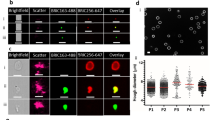Abstract
CUMULATIVE membrane damage and loss is thought to occur in the erythrocytes of individuals homozygous for haemoglobin S (refs 1–4). The culmination of this process seems to be the formation of irreversibly sickled cells (ISC), which will not resume normal biconcave disk shape, even when the haemoglobin which they contain is in the sol (oxygenated) state5–7. Although the processes responsible for the formation of ISC have not yet been fully elucidated, it is clear that a change in the structure or composition of the membrane has occurred, such that cellular plasticity and ability to resume normal shape upon oxygenation have been lost. Weed et al.8 report a similar loss of plasticity, a diminished ease of ingress into glass microcapillaries, when calcium is placed inside resealed membrane “ghosts” made from normal human erythrocytes. In whole red cells, diminished filterability was also found to occur concomitantly with progressive loss of ATP. ATP-depleted red cells, however, retained most of their plasticity if EDTA were added to the incubation mixture to prevent calcium accumulation8. These results indicate that increased calcium alone may markedly reduce red cell plasticity.
This is a preview of subscription content, access via your institution
Access options
Subscribe to this journal
Receive 51 print issues and online access
$199.00 per year
only $3.90 per issue
Buy this article
- Purchase on Springer Link
- Instant access to full article PDF
Prices may be subject to local taxes which are calculated during checkout
Similar content being viewed by others
References
Jensen, W. N., Bromberg, P. A., and Bessis, M. C., Science N.Y., 155, 704 (1967).
Padilla, F., Bromberg, P. A., and Jensen, W. N., J. Lab. clin. Med., 72, 1000 (1968).
Jensen, W. N., Am. J. med. Sci., 257, 355 (1969).
Jensen, W. N., Bromberg, P. A., and Barefield, K., Clin. Res., 17, 464 (1969).
Döbler, J., and Bertles, J. F., J. exp. Med., 127, 711 (1968).
Bertles, J. F., and Milner, P. F. A., J. clin. Invest., 47, 1731 (1968).
Bertles, J. F., and Döbler, J., Blood, 33, 884 (1969).
Weed, R. I., LaCelle, P. L., and Merrill, E. W., J. clin. Invest., 48, 795 (1969).
Tosteson, D. C., Shea, E., and Darlin, R. C., J. clin. Invest., 31, 406 (1952).
Tosteson, D. C., Carlsen, E., and Dunham, E. T., J. gen. Physiol., 39, 31 (1955).
Tosteson, D. C., J. gen. Physiol., 39, 55 (1955).
Reviewed in Bertin, L. P., Principles and Practice of X-Ray Spectroscopic Analysis (Plenum Press, New York, 1970).
Jandl, J. H., Simmons, R. L., and Castle, W. B., Blood, 18, 133 (1961).
Charache, S., and Conley, C. L., Blood, 24, 25 (1964).
Dintenfass, L., J. Lab. clin. Med., 64, 594 (1964).
Schmid-Schönbein, H., and Wells, R., in Abstr. Int. Soc. Hemorheology, 2nd Int. Conf., Heidelberg, Germ., 25 (1969).
LaCelle, P. L., Kirkpatrick, F. H., and Udkow, M., in Erythrocytes, Thrombocytes, Leukocytes (edit. by Gerlach, E., Moser, K., Deutsch, E., and Wilmanns, W.) (Georg Thiem, Stuttgart, 1973).
Author information
Authors and Affiliations
Rights and permissions
About this article
Cite this article
EATON, J., JACOB, H., SKELTON, T. et al. Elevated Erythrocyte Calcium in Sickle Cell Disease. Nature 246, 105–106 (1973). https://doi.org/10.1038/246105a0
Received:
Issue Date:
DOI: https://doi.org/10.1038/246105a0
This article is cited by
-
The Role of Cytoskeleton of a Red Blood Cell in Its Deformability
Journal of the Indian Institute of Science (2021)
-
Shape oscillations of single blood drops: applications to human blood and sickle cell disease
Scientific Reports (2018)
-
Cation Modulation of Hemoglobin Interaction with Sodium n-Dodecyl Sulfate (SDS). III: Calcium Interaction with R- and Mixed Spin States of Hemoglobin S at pH 5.0: The Musical Chair Paradox
Cell Biochemistry and Biophysics (2013)
-
Cation Modulation of Hemoglobin Interaction with Sodium n-Dodecyl Sulfate (SDS). II: Calcium Modulation at pH 5.0
Cell Biochemistry and Biophysics (2011)
-
Alterations in Ca2+ homeostasis in rat erythrocytes with atrazine treatment: positive modulation by vitamin E
Molecular and Cellular Biochemistry (2010)
Comments
By submitting a comment you agree to abide by our Terms and Community Guidelines. If you find something abusive or that does not comply with our terms or guidelines please flag it as inappropriate.



